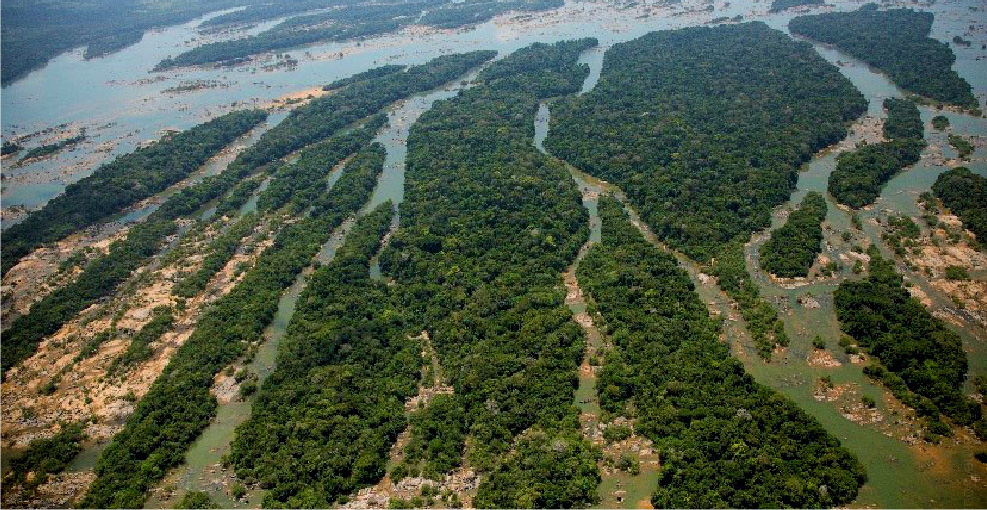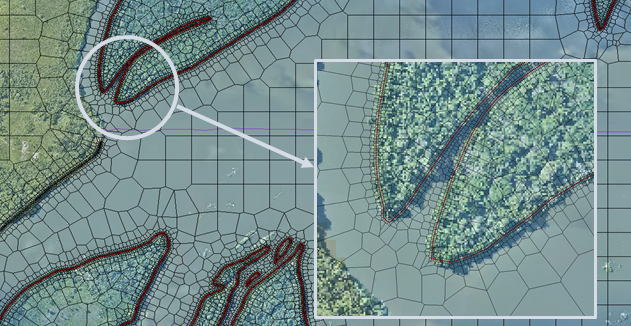Simulation of the hydrological-hydrodynamic functioning, prediction operational scenarios and extreme events, evaluation of sediment transport conditions and subsidization solutions for the recovery of degraded areas, in water courses, hyd[i]raulic structures, fish passage systems and even watersheds in an integrated way, is an increasingly evident need.
To meet this demand for water resource solutions, Tractebel's multidisciplinary Environment team has innovated in methodologies for consolidating geotechnological and hydrometric information and in the development of the DEM (Digital Elevation Model), which support a representative basis for mathematical models of hydrodynamic simulation applicable to projects and evaluations of different segments.
Currently, an example of an environment that is being modeled is found in the Volta Grande do Xingu region, in the Reduced Flow Stretch of about 110 km, downstream of the Belo Monte HPP, in Pará. In addition to the compilation of information from aerial surveys and topobatimetric sections, it was necessary to apply Artificial Intelligence (AI) techniques and use a supervised learning algorithm that, through Principal Component Analysis, assists in the interpolation and generation of the submerged riverbed between the sections raised in the field.

Low flow section of Volta Grande do Xingu, considered of great morphological complexity
The main objective of this work is the elaboration of a hydrodynamic model that allows the spatialization of the flood spots resulting from the simulation of natural flow scenarios, as well as the comparative assessment with the operational flow scenarios of the plant, thus quantifying the extent and periodicity of areas that are no longer flooded, with particular attention to alluvial forests.
In view of the morphological complexity of the area and in view of the detail and scale of responses to the specific demands of the bodies involved in the environmental licensing process, this type of work deserves mention as an application of 2D hydrodynamic modeling for integrated socio-environmental assessment and prognosis of impacts, in relation to the conditions of navigation, fishing and other uses of the river, as well as the alteration of the dynamics of flooding of the aquatic habitats, important for the sustainability of the environment in question.

2D hydrodynamic model set

Consolidation of the basis for hydrodynamic modeling
GIS application for flood control systems
Highlight can also be given to the use of hydrodynamic modeling in other projects and studies at Tractebel linked to hydroenergetic uses, river navigation, water quality, water availability, sediment plume dispersion, dam safety and mining structures. The application in water resilience studies and watershed management is also a reality. As an example, there are the modeling and integration with GIS tools for the adoption of non-structural measures in flood control systems in urban areas, as well as studies of the propagation of the hypothetical rupture hydrograph and potential areas susceptible to Dam Breaks.
As hydrodynamic modeling products, in addition to the characterization of hydraulic variables of interest, such as depth, elevation and flow velocity, flood maps are also prepared. This form of spatialization, usually used to present the results of the modeling, varies depending on the applications of the study, and can be maps for planning and operation, as well as maps for alerts. The latter is generally applicable for monitoring the study of floods, based on the observations of the linimetric rules, and when associated with a level forecasting system, it can be used, by the responsible authorities, as a tool for planning actions aimed at minimizing damage caused by extreme events. Additionally, in order to help the spatial understanding of the results of a modeling, it is also possible to create digital models for visualization in virtual reality, with particular utility in presentations with different participants and stakeholders.
Dams Characterization and Degraded Area Recovery Projects
With a qualified, multidisciplinary team and dedicated computational resources, Tractebel is able to develop environmental and engineering services related to projects for the recovery of degraded areas and dam de-characterization projects that also involve hydrodynamic modeling. In this context, a study of executive alternatives for the silting of PCH Madame Denise is currently being developed, which involves geological-geotechnical, hydrological and hydrosedimentological assessments consolidated with the execution of hydraulic modeling activities, in addition to the elaboration of the environmental diagnosis of the area of influence of the enterprise that will support the environmental licensing with the licensing agency for the implementation of the alternative developed and chosen as the most viable for implementation.
In relation to the dam de-characterization services, we carry out the activities of review and evaluation of engineering projects in the consolidation and approval phase (Design Review), as well as for the elaboration and development of the same ones, with modeling and geological-geotechnical evaluations. and hydrological/hydraulic using internationally recognized software.
In addition, in the environmental universe, our team of specialists assesses and verifies the possible impacts inherent to the implementation of the de-characterization projects, as well as monitors and executes all environmental licensing procedures together with the respective licensing agencies. In this way, giving the customer all the safety and technical quality to the services performed in all its scope, both in the aspects of geotechnical and structural engineering and in the social and environmental aspects, avoiding problems and integration failures that are common in services of this nature and, consequently, optimizing and streamlining the entire process involved.







